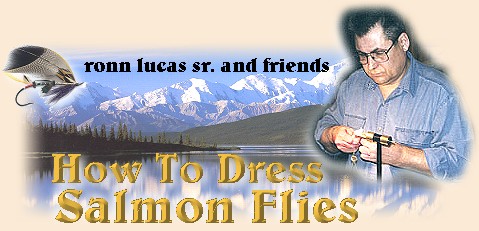The Hooks
We Tyers are lucky to be living when we do. There any number
of hooks available to us today that would have Tyers of a
hundred years ago dripping with envy. Our hooks come from
literally all points of the globe. We also live in a
technologically rich time when the science of metallurgy
and technical know-how to make modern hooks is at it's peak.
Now, don't get me wrong, the early hooks given the resources
the hook makers, had were marvels of their day too. Some were
even artworks in their own rights.
The Salmon hook was really refined in England more than any
other country. Yes, there were influences from other countries
such as Scotland, Ireland and, others but, England had some
of the premier hook makers up to this day. Partridge of Redditch
was one of the leaders in the Salmon hook business for many years
and, they brought us many shapes and size hooks that just weren't
available from other makers.
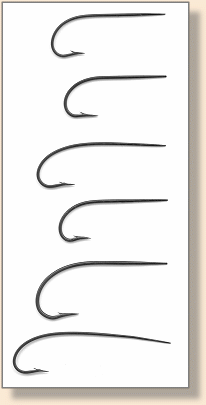
Top to bottom, Lucas, Antique T E Pryce-Tannatt, Partridge Bartleet
CS10/3, Partridge Adlington & Hutchinson, Heritage, Partridge XL
Bartleet HE2
The O Mustad & Son hook company of Norway has also been in the
hook business for over 150 years. Theirs is the single largest
hook making operation in the world. A couple years ago, Mustad
purchased the Partridge Hook Company and have moved the hook
making operation to Asia and other parts of the world. Many
loyal users of Partridge hooks were not happy with this development.
Change is often a difficult thing to endure. I must say the hooks
made during the transitional period were somewhat disappointing
to this Tyer.
I can say that the current hooks from Partridge I have seen are
as good or better than the old ones ever were. Their finishes
which I found to be poor during the "dark days" are now excellent
and, the hooks are sharp. I hope they continue to bring us the
shapes and sizes of hooks for a long time to come.
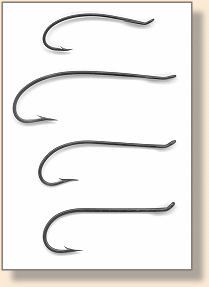
Top to Bottom, Partridge CS14/1B, Partridge Bartleet CS10/1,
Mustad 80500BL, Mustad 36890.
There are other hooks coming out of Asia under different names
such as Tiemco, Daiichi and, others. Daiichi has some fine
Alex Jackson Salmon hooks that are a very handsome shape.
Heritage hooks are still produced in a shop in England and are
very nice for their blind eye display hooks. They also are good
for fishing of course. If you are tying display flies and want
an antique look to the flies, Heritage hooks are great. Castle
Arms imports these into the USA so, they are available.
This brings me to a fellow by the name of Ron Reinhold who has
a hook making shop in Williamsburg MI. I've not been fortunate
to have visited his place but, it must be fantastic. His hooks
are made from scratch, on machines he designed and built. The
hooks are hardened with precision so, they are good for display
or fishing (if you have deep pockets). He makes just about every
antique hook shape that was made, faithfully following every
curve and feature. He produces a couple grades of hooks, great
and, even better (my words)! Ron will even custom make hooks
for the customer! Of course, all this great service and, attention
to detail comes with a price. His hooks vary in price from rejects
(Still beautiful hooks!) for $5 each to $11 each for his traditional
style hooks and, up to $25 for exhibition grade hooks which are
flawless examples of hand made hooks.
To indicate how proud Ron is of his work, he signs and dates
the hooks (actually, the bag they come in). His display hooks
are placed in a nice wrapper like hooks of old.
The picture of Ron's hooks don't and, can't show the details of
them due to the limitations of this media but, when you are
holding his hooks, the true beauty is abundantly clear. His hooks
have "soul." By that, I mean, they have been crafted by someone
who knows what he is doing and, why he does it. It's like a fly
tied by a Tyer who understands his/her materials, the insects,
the behavior of the fly in action and, why the fish will take it.
Do you get the impression that I am fond of Ron's handiwork?
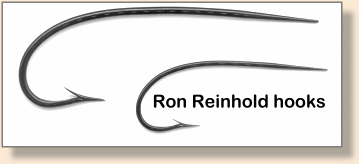
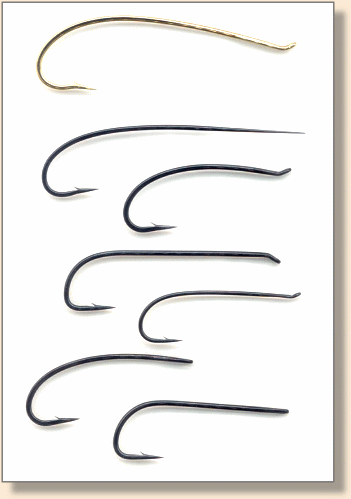
Daiichi Hooks from top, #2055 Alec Jackson Spey Fly Hook, gold finish,
#2091 Alec Jackson Blind Eye, #2161, #2271 Dee/Streamer, #2131
Bob Veverka's "Classic Salmon Hook," #2151, #2141.
Earlier I mentioned the beautiful Alec Jackson hooks that Daiichi
makes. They make many more Salmon/Steelhead hooks too. Most of
the designs are thoroughly contemporary in design and quality.
They also have a few other hooks suited to Salmon/Steelhead flies
that I have not listed. As is the case with just about every Asian
hook brand, Daiichi quality is high. I have used their hooks for
many years and have never been disappointed with their products.
If you happen to get terminally bitten by the display fly bug,
you may be one of those few Tyers that even go to the extremes
of making your own hooks! Some, myself included, take existing
hooks and reconfigure them to their personal needs. Some of the
challenges encountered are the re-hardening of the hooks assuming
you have heated them to soften the metal. The other is to put a
good durable finish on them that won't chip.
If you take an existing eyed hook and just heat the area of the
eye to soften it for converting it to a blind eye hook, you can
probably get by using it for fishing if you wanted to although,
if you don't reharden the now soft end of the hook, it will bend
easily. If you soften the whole hook as I often do, it is extremely
difficult to re-harden it without hard or soft spots so, these
are better left for framing.
Some Tyers will start their hook making from raw high carbon wire.
This means they will have to make a "knife" for cutting the barb,
forming the point taper the blind eye and, bend the hook.
There is a chapter about hook making by Eugene Sunday in Tying
the Classic Salmon Fly in which he describes reconfiguring
hooks. There is also an article in the Summer 1998 issue of Fly
Tyer written by John Betts. John takes the hook making from
the wire state and gives good info and photos on the subject.
Even if you have followed the instructions from one or both of
these authors, you still have the problem of finishing the hooks
you have just created. I could not get either of their finish
systems to work for me. That's not to be taken as a knock on
their ways of dealing with finishing their hooks and, I am sure
they have it refined to a point that works great for them. But,
like many things in Tying, others techniques may not work for
someone else.
The system I find that works for me is as follows. Yes, I realize
it may not work for everyone but, after reading my way and those
of Eugene and John, you will have three perspectives from which
to develop one that's your own.
I take the softened hook and straighten it with some very large
smooth face pliers I have only found at Sears in the tool section.
Sorry, don't know what they are called. One pair is about a foot
long so it gives you tremendous leverage for straightening the
hook. In fact, you can even flatten a small wire with them! Rotate
the wire while squeezing to remove the bends. This will take a
little practice but, straightening the wire this way as opposed
to using a hammer and anvil will result in unmarred wire which
will require much less grinding to smooth out.
At this point, I have a straight hook. I use a very small grinding
wheel in one of my dental grinders to shape the hook point and
gutter. A variable speed Dremel grinder will work too. For
tapering the blind eye, I hold the straight wire in the jaws
of the pliers, which have a few serrations that go across the
face of the jaws just at the tips. I filed a couple grooves
slightly to accommodate the hook. Then, I hold the end of the
wire in the pliers in my left hand and, guide it past a 1" or
so barrel shaped grinding wheel while I rotate the wire. This
produces a perfectly shaped round blind eye. You need not
smooth this area. All the other finish work I do to the wire
is done lightly with a Scotch pad like grinding wheel. It's
a grinding wheel that is made of compressed Scotch pad material.
You should be able to find these without too much trouble. Now,
I shape the hook. I started out doing it by hand and eye. This
will work but, you will not have really consistent results. I
have made a couple prototype bending jigs that work great and
every hook is like the last one. I haven't had time to make
full sets of any of the hook shapes I like but, someday I
hope to be able to finish them.
Now, you have a hook ready to be finished. I tried all kinds
of different paint and finally found one that works for me. It
is High Temp Engine Enamel by Plasti-Coat. The black paint is
great, the colors are less than satisfactory sense all of them
turn brown when they are baked. I thin the paint at least 1 to1
with Ful-Base 441-20 Fast Reducer by Nason. This is a "hot"
commercial thinner that auto paint suppliers will have. I dip
the hook while holding the tip of the eye with forceps and hold
it far enough over a bunsen burner that it won't catch on fire.
Yes, this is dangerous and you need to be very, very careful
if you go this way. A hair dryer will work too. The reason I
use dental grinders and bunsen burners is that I am a Dental
Technician , so I have these tools at my disposal. Anyway,
your hook may require two or three quick dipings and dryings
to get JUST ENOUGH to cover the metal. If it is too thick,
the hook will chip as the vise jaws compress it. As you dip
the hook, make sure the area of the barb doesn't fill with
paint. You can clean it by touching with a pin or tooth pick
to wick the paint from the area.
Now, you need to bake the paint. I made a wire rack to hang
the hooks from while they are in the oven. I used ½" hardware
cloth for it but, sometimes, the galvanization will stick to
the paint. Not often though so, it is an option. I also made
a metal holder that has holes drilled to insert the eye into
while it is being baked. This seems a better solution since
the eye area can be painted later and most of it will be
covered by the dressing anyway. You can bake the hooks up
to 400 degrees F. The higher the temp, the less glossy the
finish will be. You can get a gloss finish at about 300
degrees but, it will be somewhat soft. The 400 degree temp
will give you a very hard surface. In any case, use these
hooks with some protection when they are in the jaws of your
vise. I use paper like cereal boxes are made of. Put the
non-glossy side to the paint and, clamp only hard enough
to hold the hook.
At one point, I thought I had found the holy grail of hook
making when I discovered some powder coat paint. The problem
was, it is nearly impossible to get a very thin coat by hand
dipping the hooks. It is hard stuff and is glossy and, has
a lot of colors. But, it just wasn't to be.
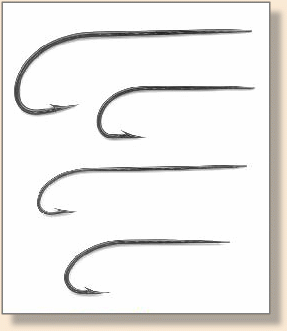
Blind Eye Hooks by Ronn Lucas, Sr.
If you are tying flies to fish, the design of the hook
will be dictated by the type of fishing conditions you
will be using them under. If they are intended for display,
the design of the hook can play a major role in the finished
look of the fly.
Salmon/Steelhead hooks are typically up, loop eye and, black.
To be honest, I have never heard the definitive reasons for
this configuration other than, tradition. One thing most Tyers
agree on is that they look good and, lacking any reason not
to use them, we do. Spey and Dee flies were typically long
shank flies where as dry flies require a light wire hook.
I will leave the hook choice to you to determine to best
meet your particular requirements. Some of the following
patterns may be tied on hooks ill suited to your needs so,
just tie on the hook of choice.
One other note regarding hooks. The early hooks were made
without eyes and a Silk gut loop was tied to the hook. These
didn't last long when the flies were in use. We still use this
type of hook for most display flies though. Some Tyers do use
flies with gut loops for fishing mostly I suppose to give them
a connection to the traditional ways. There is nothing wrong
with the traditional ways but, I encourage Tyers to
experiment and, break the rules to suit their needs and
preferences.
Happy Trails! ~ Ronn Lucas, Sr.
Next time, the Feathers.
Back to Index
|
